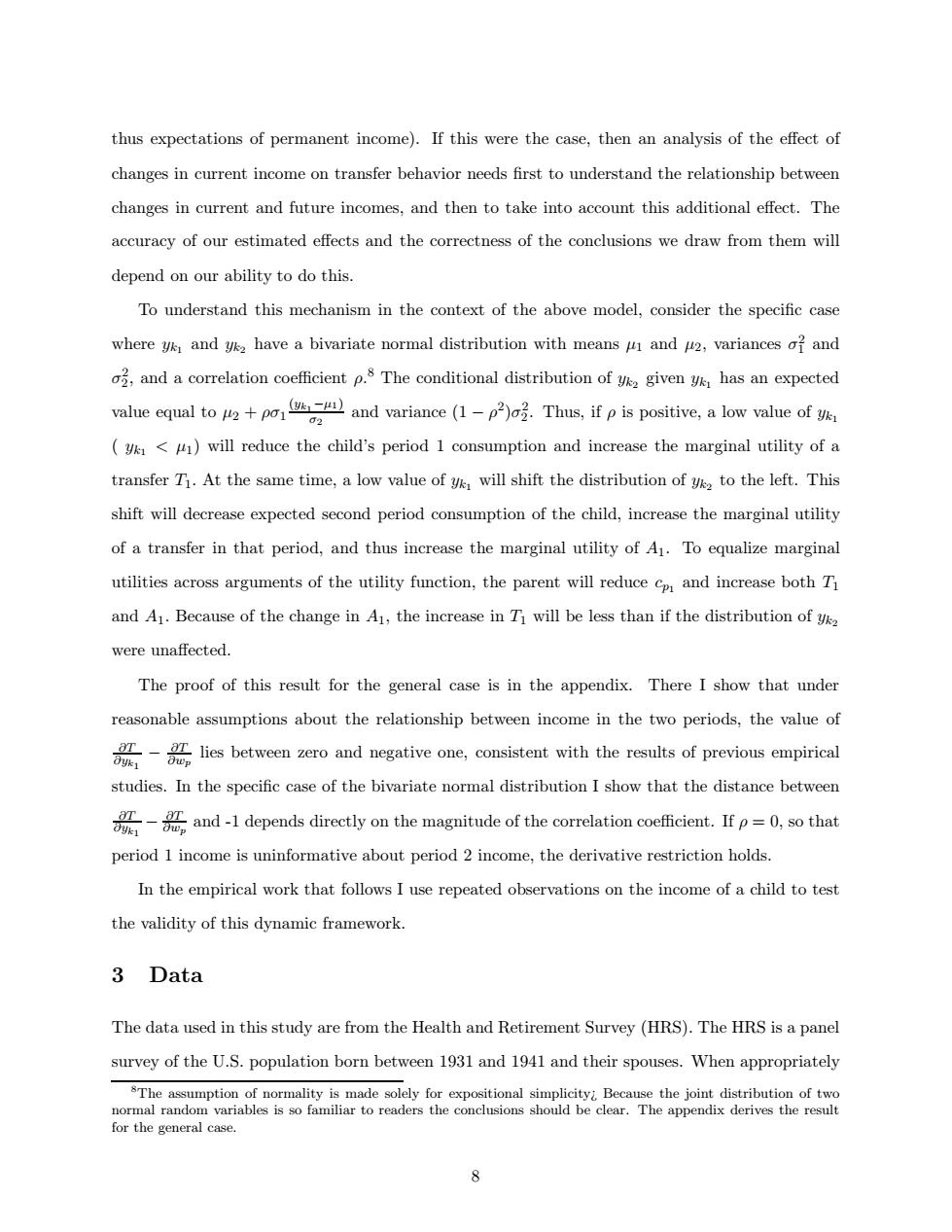正在加载图片...

thus expectations of permanent income).If this were the case,then an analysis of the effect of changes in current income on transfer behavior needs first to understand the relationship between changes in current and future incomes,and then to take into account this additional effect.The accuracy of our estimated effects and the correctness of the conclusions we draw from them will depend on our ability to do this. To understand this mechanism in the context of the above model,consider the specific case where yk and ykz have a bivariate normal distribution with means u and u2,variances of and 2,and a correlation coefficient p.The conditional distribution of y given y has an expected value equal topand variance (1-).Thus,if p is positive,a low value of 02 (y<)will reduce the child's period 1 consumption and increase the marginal utility of a transfer T1.At the same time,a low value of will shift the distribution ofy to the left.This shift will decrease expected second period consumption of the child,increase the marginal utility of a transfer in that period,and thus increase the marginal utility of A1.To equalize marginal utilities across arguments of the utility function,the parent will reduce cp and increase both Ti and A1.Because of the change in A1,the increase in Ti will be less than if the distribution of y were unaffected. The proof of this result for the general case is in the appendix.There I show that under reasonable assumptions about the relationship between income in the two periods,the value of lies betweener and negative,conistent with the resut of previous empirical studies.In the specific case of the bivariate normal distribution I show that the distance between and-1 depends directly on the magnitude of the correlation cfficient.Ifp,s that period 1 income is uninformative about period 2 income,the derivative restriction holds. In the empirical work that follows I use repeated observations on the income of a child to test the validity of this dynamic framework. 3 Data The data used in this study are from the Health and Retirement Survey(HRS).The HRS is a panel survey of the U.S.population born between 1931 and 1941 and their spouses.When appropriately SThe assumption of normality is made solely for expositional simplicityi Because the joint distribution of two normal random variables is so familiar to readers the conclusions should be clear.The appendix derives the result for the general case. 8thus expectations of permanent income). If this were the case, then an analysis of the effect of changes in current income on transfer behavior needs first to understand the relationship between changes in current and future incomes, and then to take into account this additional effect. The accuracy of our estimated effects and the correctness of the conclusions we draw from them will depend on our ability to do this. To understand this mechanism in the context of the above model, consider the specific case where yk1 and yk2 have a bivariate normal distribution with means μ1 and μ2, variances σ2 1 and σ2 2, and a correlation coefficient ρ.8 The conditional distribution of yk2 given yk1 has an expected value equal to μ2 + ρσ1 (yk1 −μ1) σ2 and variance (1 − ρ2)σ2 2. Thus, if ρ is positive, a low value of yk1 ( yk1 < μ1) will reduce the child’s period 1 consumption and increase the marginal utility of a transfer T1. At the same time, a low value of yk1 will shift the distribution of yk2 to the left. This shift will decrease expected second period consumption of the child, increase the marginal utility of a transfer in that period, and thus increase the marginal utility of A1. To equalize marginal utilities across arguments of the utility function, the parent will reduce cp1 and increase both T1 and A1. Because of the change in A1, the increase in T1 will be less than if the distribution of yk2 were unaffected. The proof of this result for the general case is in the appendix. There I show that under reasonable assumptions about the relationship between income in the two periods, the value of ∂T ∂yk1 − ∂T ∂wp lies between zero and negative one, consistent with the results of previous empirical studies. In the specific case of the bivariate normal distribution I show that the distance between ∂T ∂yk1 − ∂T ∂wp and -1 depends directly on the magnitude of the correlation coefficient. If ρ = 0, so that period 1 income is uninformative about period 2 income, the derivative restriction holds. In the empirical work that follows I use repeated observations on the income of a child to test the validity of this dynamic framework. 3 Data The data used in this study are from the Health and Retirement Survey (HRS). The HRS is a panel survey of the U.S. population born between 1931 and 1941 and their spouses. When appropriately 8The assumption of normality is made solely for expositional simplicity¿ Because the joint distribution of two normal random variables is so familiar to readers the conclusions should be clear. The appendix derives the result for the general case. 8